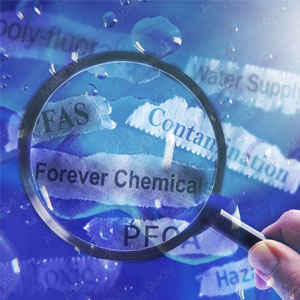Experts endorsed findings from studies by the National Toxicology Program (NTP) on two chemicals found in everyday items and their links to cancer in rodents.
One study focused on perfluorooctanoic acid (PFOA), a substance found in products such as nonstick cookware and stain- and water-resistant fabrics. The other was about oxybenzone, an ultraviolet filter found in sunscreen lotion.
 PFOA and other PFAS substances have been called “forever chemicals” because of their ability to remain in the environment for long periods of time.
PFOA and other PFAS substances have been called “forever chemicals” because of their ability to remain in the environment for long periods of time.A peer review panel chaired by Russell Cattley, V.M.D., Ph.D., from Auburn University, evaluated the studies at a Dec. 12 meeting held via webcast. Results of the PFOA discussion are detailed below. Learn about the panel’s analysis of the oxybenzone study.
Early-life exposure to PFOA
“Perfluorooctanoic acid [PFOA] is a perfluoroalkyl substance [PFAS] that was used for decades in creating nonstick properties in a variety of products,” said Chad Blystone, Ph.D., study scientist at NTP for the PFAS research program.
“It is the second most abundant PFAS measured in the human population, including children and pregnant women,” he added.
 “Due to a long half-life, measured in years, and resistance to environmental degradation, PFOA exposure continues, but it has declined,” Blystone said. (Photo courtesy of Steve McCaw)
“Due to a long half-life, measured in years, and resistance to environmental degradation, PFOA exposure continues, but it has declined,” Blystone said. (Photo courtesy of Steve McCaw)Human exposure to PFOA has been shown to occur early in development through a mother’s womb and through her milk during lactation. NTP scientists wanted to know whether such perinatal PFOA exposure was toxic and cancer-causing, so they tested the chemical in rats.
Peer reviewers agree with NTP
Researchers set up an experiment in which some rats were exposed over a lifetime, starting at embryo implantation — they were exposed both perinatally and after weaning. Another group of rats was exposed to PFOA only after weaning. Then the two groups were compared.
NTP scientists collected mothers’ and pups’ body weights, litter sizes, and blood concentrations of PFOA, and looked at whether tumors formed in a variety of tissues in the offspring.
The peer review panel agreed with NTP that there was clear evidence of carcinogenic activity following PFOA exposure in male rats and some evidence of such activity in female rats.
Next, the rats exposed to PFOA both perinatally and after weaning were compared with rats only exposed after weaning. The panel agreed that the combined effect of perinatal and post-weaning exposure on carcinogenic activity was uncertain and limited to the observation of hepatocellular carcinomas, or liver cancers.
NTP levels of evidence, from strongest to weakest: clear evidence, some evidence, equivocal evidence, and no evidence. A study may also be deemed inadequate for determining evidence.
(Sheena Scruggs, Ph.D., is the digital content coordinator for the NIEHS Office of Communications and Public Liaison.)









